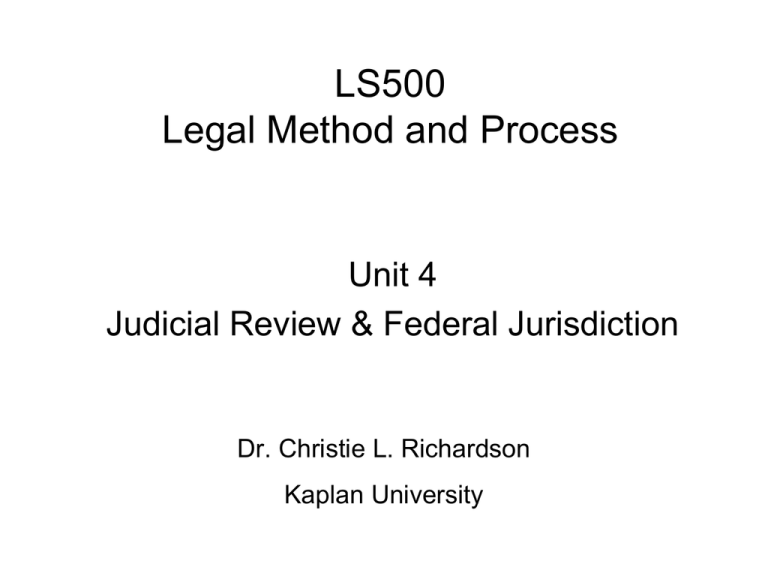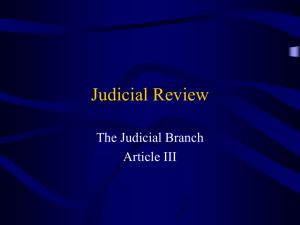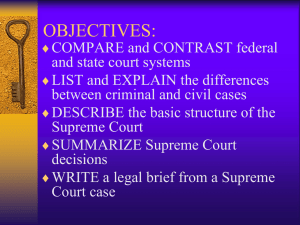Document
advertisement

LS500 Legal Method and Process Unit 4 Judicial Review & Federal Jurisdiction Dr. Christie L. Richardson Kaplan University Federal Court Structure United States Supreme Court Court of Federal Claims Court of Appeals for the Federal Circuit Court of Appeals (13 Circuits) GA - 11th Cir. Court of International Trade District Courts (94 Districts) Court of Veterans’ Appeals Court of Appeals for the Armed Forces Tax Court Courts Martial Judicial Review • Does anyone know the name of the landmark case that introduced judicial review and it still remains constitutional today? • Marbury v. Madison, 1803 – First time the U.S. Supreme Court declared something “unconstitutional”; – Established judicial review; and – Defined the checks and balances system we have in the U.S. government. United States Supreme Court • 3 ways the Supreme Court will hear a case: – File directly in the Supreme Court (original jurisdiction); – File in a lower federal court, such as a district court, and appeal up to the Supreme Court (appellate jurisdiction); or – File in a state court, appeal up through the state's highest courts, and then appealing to the Supreme Court on an issue of federal law (appellate jurisdiction). • Writ of Certiorari United States Supreme Court • The constitutional issue on which Marbury v. Madison was decided was whether Congress could expand the original jurisdiction of the Supreme Court. • William Marbury, was designated as a justice of the peace in the District of Columbia. Marbury and several others were appointed to government posts created by Congress in the last days of John Adams's presidency, but these lastminute appointments were never fully finalized. The disgruntled appointees invoked an act of Congress and sued for their jobs in the Supreme Court. United States Supreme Court • Because Marbury filed his petition directly in the Supreme Court, the Court needed to be able to exercise original jurisdiction over the case in order to have the power to hear it. • Marbury argued that the Constitution was only intended to set a floor for original jurisdiction that Congress could add to (Article III). The Court disagreed and held that Congress does not have the power to modify the Supreme Court's original jurisdiction. Consequently, the Court found that the Constitution and the Judiciary Act conflict. United States Supreme Court • Acts of Congress that conflict with the Constitution are not law and the Courts are bound instead to follow the Constitution, affirming the principle of judicial review. • Since it is a court's duty to decide cases, courts have to be able to decide what law applies to each case. Therefore, if two laws conflict with each other, a court must decide which law applies. United States Supreme Court • The justices held, through forceful argument, that the Constitution was "the fundamental and paramount law of the nation" and that "an act of the legislature repugnant to the constitution is void." In other words, when the Constitution--the nation's highest law--conflicts with an act of the legislature, that act is invalid. • Decision 6-0 for Madison. • Today we have 9 Justices on the Court. Mootness • If the outcome of a case will have no significant impact on the litigants, it is moot - “neither side would gain in the immediate dispute no matter how the court ruled”. – The case will generally be thrown out. • If ripeness involves a plaintiff filing a premature claim, mootness represents the opposite situation. – A plaintiff being too late to seek relief from the courts. – Courts do not decide dead issues. • The passage of time or a change in circumstances may make an issue moot. Standing Layman’s Terms • In a noncriminal case, a litigant must have standing - he or she must have a personal stake in the outcome of the controversy so that the adversarial model will be fully operative. Standing • 3 basic components (elements) provide some degree of specificity. – Case involves an actual dispute and not merely a theoretical one. • Must be “definite and concrete”. • Must be a real and substantial controversy. • Courts will only hear concrete disputes and not abstract issues. – Incorporates the requirement adversity. • Courts require that the parties in the lawsuit have something to lose and therefore will argue and present issues with an intensity and vigor not found in a disinterested litigant who has not personal stake in the case outcome. • Tries to rule out “friendly” lawsuits - lacking true adversity. – Legal injury suffered by the plaintiff must be direct. • Litigant must have a substantial and immediate interest in the litigation. • One may not bring a lawsuit solely on behalf of a third party (neighbor), except legal guardian or next-of-kin. Class Actions • Standing requirements for group use in courts have 4 prerequisites. – There must be so many people in the class (group) that it would be impractical to name them all as individual parties. – The class must be clearly recognizable by virtue of its well-defined interest that raises the same questions of law and fact. – The representative parties’ claims must be typical of the class’s claims. – The representative parties must fairly and adequately protect the interests of the class. • If all 4 requirements are met, the court will certify that the class may maintain the lawsuit. Ripeness Doctrine • In order to bring a case, the plaintiff must demonstrate harm that is specific rather than merely theoretical or speculative. • Not every case is specific . . . At some point the harm moves from theoretical to specific (live). • When this occurs, the legal issues involved have evolved to a point that a clear decision can be reached. Ripeness - Demonstrated • Poe v. Ullman, 367 U.S. 497 (1961) – Litigation contesting Connecticut’s law prohibiting the sale of birth control devices and also the dissemination of information about birth control. – To clear away legal obstacles to the opening of a birth control clinic in New Haven, the law was challenged, but the Court dismissed the case on the grounds that the law had never been enforced. Ripeness - Demonstrated • Griswold v. Connecticut, 381 U.S. 479 (1965) – Poe reached Griswold. – The issue could no longer be dismissed for lack of ripeness, and the Court overturned the Connecticut law as a violation of the newly discovered constitutional right to privacy. References • Altschuler, B. E., Sgroi, C. A., & Ryniker, M. R. (2010). Understanding law in a changing society. (3rd ed.). Boulder, CO: Paradigm Publishers. • Nowak, J. E., & Rotunda, R. D. (2010). Principles of constitutional law. (Fourth ed.). St. Paul, MN: Thomson Reuters.







